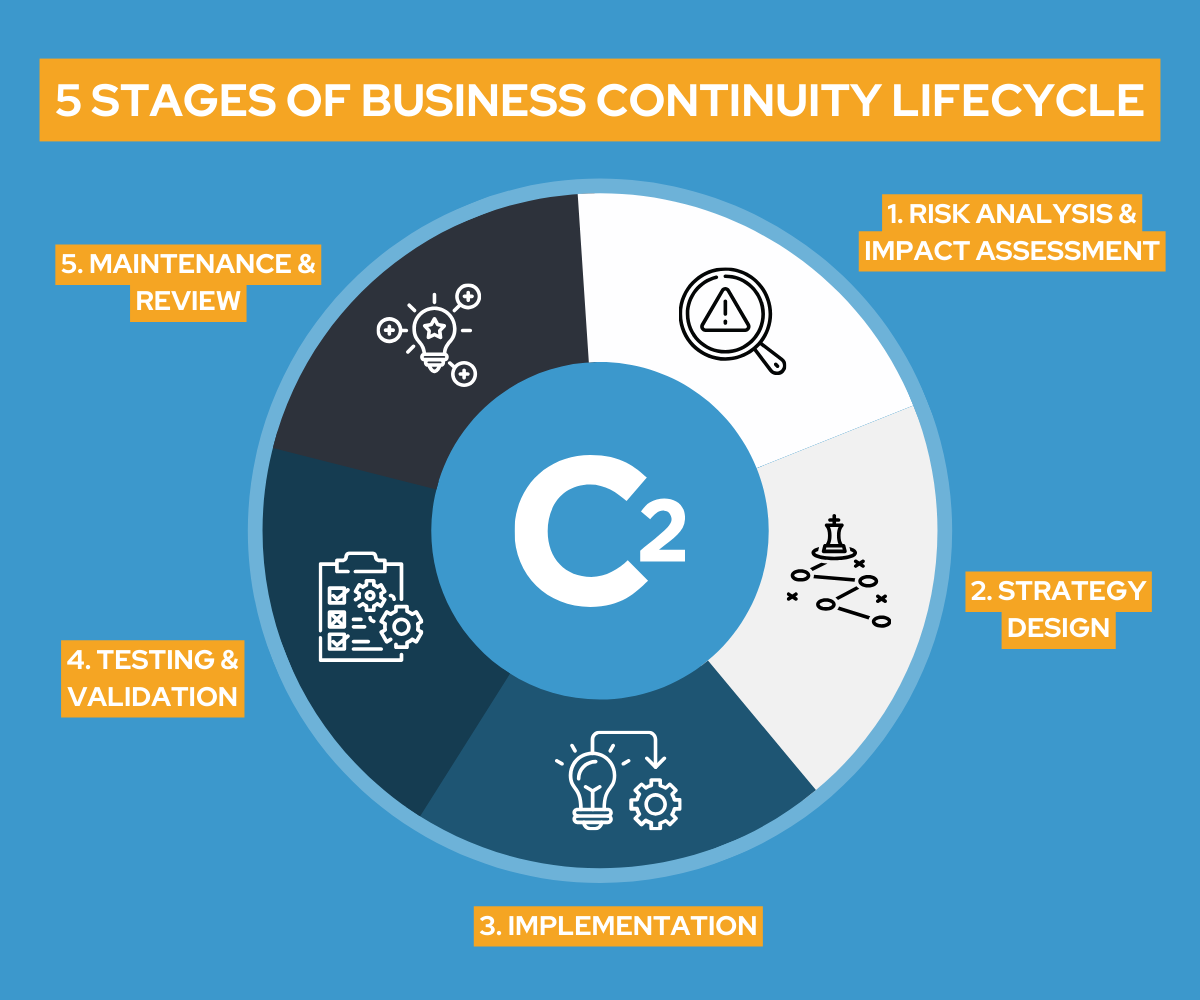What Is Business Continuity Management?
Published on September 05, 2018
Last updated on March 03, 2025
Jump to a section
Business Continuity Management (BCM) is a key business strategy that proactively prepares organisations and their staff to cope in times of disruption. What would you do if you woke up tomorrow and discovered your entire IT system was down, supply chains and customers were unable to reach you? Would your business survive? If you can't answer this right away and with confidence, you need a business continuity plan.
Every business faces unique risks. The business continuity lifecycle helps identify threats, assess their impact, and build resilience to ensure an effective response. BCM is not just about having a plan. It's about creating, maintaining, and improving a system that ensures organisations can respond effectively to disruptions. It helps safeguard the interests of an organisation's key stakeholders, reputation, brand, and value-creating activities.
How Is BCM Different From a Business Continuity Management System?
A business continuity management system (BCMS) is the structured framework that organisations use to implement and maintain business continuity strategies. To ensure a comprehensive and substantial approach to business continuity, systems may require you to adhere to specific frameworks or certifications. One of the most commonly used is ISO 22301, which demonstrates an organisation's willingness and ability to remain compliant.
According to ISO 22301, an effective BCMS must focus on:
- Understanding the organisation's needs and the necessity for establishing a business continuity management policy and objectives
- Implementing and operating controls and measures for managing an organisation's overall capability to manage disruption
- Monitoring and reviewing the performance and effectiveness of the BCMS
- Continual improvement based on objective measurement.

What Is BCM All About?
Many make the mistake of thinking that BCM is all about disaster response. However, it is much broader than it first appears, examining operational, financial, and reputational impacts and physical risks. In addition to those already mentioned, it has now grown to encompass a range of risks, such as:
- Interruption risks
- Personnel risks
- Legal/regulatory/compliance risks
- Third-party risks
- Supply chain risks
- Service provision risks
- Technical risks
- Reputational/brand risks
- Political/societal risks
- Environmental risks
What Are the Differences Between Business Continuity Management and Disaster Recovery?
Business continuity management and disaster recovery both play essential roles for any business. Many confuse them as being the same, which could be costly as it deprives you of building a robust approach to business continuity planning.
Business continuity ensures operations continue despite disruptions, while disaster recovery focuses on restoring critical functions after an incident.
Think of it this way: the BCM is the airbag in your car—it keeps you and other occupants safe during impact and minimises damage. The disaster recovery is the garage, helping to repair the damage and get you back on the road as soon as possible.
To help protect the critical functions of your business, it's best to start by identifying the key differences between business continuity management and disaster recovery. Here is a closer look at those differences.
Staying Operational vs Restoring Business Functions
Business continuity ensures that the entire organisation can stay operational even during a disaster. On the other hand, disaster recovery is about restoring the critical functions of the business, such as vital software and IT infrastructure, in light of the disruptive incident.
Simply put, business continuity is about remaining operational when circumstances are less than ideal. Meanwhile, disaster recovery is a series of steps to help restore the vital aspects of a company and reduce recovery time.
Reducing Downtime vs Reducing Inefficiencies
One of the key differences between business continuity management and disaster recovery is that they serve unique purposes. Business continuity management aims to reduce downtime in business operations, while disaster recovery strategies reduce any inefficiencies in the process or critical functions of the business. With these two, you can prepare for any disruption, big or small.
Disaster recovery plans are often part of an overall business continuity management plan. Disaster recovery is critical to your business resilience because it focuses on the individual aspects or moving parts that help keep businesses running. Without this, your business continuity plan won't be effective.
How Can BCM Help You Meet Regulatory Requirements?
Business continuity plans are vital for improving your business resiliency, especially when managing potential threats and disaster scenarios. A growing body of legislation also requires businesses to develop effective continuity management protocols to ensure normal operations are restored in the shortest amount of time following a disruptive incident.
This is not just exclusive to businesses in the UK but applies globally. Corporate governance regulations expect business leaders and organisations to exercise reasonable care and diligence in risk management. Managing and mitigating those risks is vital to the organisation's ability to quickly recover from any threats.
One of the most common risks that could affect organisations today is cyber threats. There are regulatory requirements, like the HIPAA law in the US, to ensure that all businesses have security techniques and measures in place to prevent and protect from cyber attacks. Organisations can do this by enhancing their technology infrastructure and preventing unauthorised access to their critical data systems, which could lead to data loss or theft.
It's important to address these vulnerabilities as part of your business continuity plans and disaster recovery strategies to ensure that no such event would happen. At the same time, it is also a way for you to protect customers and their personal data from cyber threats.
For this reason, regulatory requirements from the government are enacted to protect the rights of customers dealing with your business. It is your responsibility to ensure their protection, not just for the sake of your business.
Failing to meet regulatory requirements doesn't just put your business at risk—it puts customer trust and corporate reputation on the line. By integrating regulatory compliance into your BCM strategy, you ensure resilience, security, and long-term success.
3 Key Components of a Business Continuity Plan
How do you ensure business continuity when facing risks and potential disasters?
Data is one of the biggest assets of any company. Therefore, preventing data loss is vital to your business continuity management efforts. It's no longer optional to protect data; it is a must. Therefore, you should regularly update your business continuity plans and disaster recovery strategies. It will ensure that you have a robust plan for when threats and risks threaten to derail your critical business processes.
To ensure that you have a robust business continuity management system, these key elements must be present:
1. Recovery Personnel
Successful business continuity management is built from the top to down. Who is in charge when disaster strikes? Without a clearly defined leadership structure, response efforts can fall apart. That's why recovery personnel—senior executives, department heads, and crisis teams—are a crucial part of a BCM plan. Once you have the support of senior management, you can build a dedicated team to put together business continuity and disaster recovery plans.
The team itself should have a chain of command. Therefore, you must clearly define the roles and responsibilities of each team member. Make sure you have a list of the key dependencies to avoid assigning redundant tasks and make the most of each personnel.
2. Recovery Procedure
The next critical component of effective business continuity management is the recovery procedure. You must outline the strategy for every critical business function. This approach allows you to prioritise the essential business process vital to ensure business continuity. It also enables you to optimise your use of manpower and resources to ensure a faster recovery.
Moreover, you can also prioritise the critical functions of your business in terms of risk management and the risk analysis phase. The more understanding you have of potential threats, the better you can protect critical processes from disruptions.
3. Data Backup
Many organisations that suffered from a data breach have suffered significantly to the point that they cannot recover. Don't let your company be one of them. You must boost your IT infrastructure and ensure that all security protocols are updated. Make sure you have a backup for all data to avoid crippling your business functions in case of a cyber attack.
You should always think one step ahead when preserving your assets and ensuring business continuity. Data backup is critical to business continuity management and disaster recovery plans.
5 Phases of Business Continuity Management

1. Risk Analysis & Impact Assessment
The first stage of any business continuity management process must be to identify the potential threats that could impact your operations. Risks can come from any direction, both internally and externally, and they can affect small companies as easily as they affect mega-conglomerates that operate on an international level.
Even something as simple as a change in compliance can be considered to be a risk. As regulators tighten restrictions and ramp up sanctions and fines, companies that do not comply put themselves at great risk of operational issues. A full risk assessment and analysis must be carried out along with an impact assessment so companies can be sure of the issues they face.
2. Strategy & Design
With the data gathered from your risk assessment, you can now move forward and develop a business continuity strategy. This will likely include multiple stages and further developmental strategy as you need to ensure that every process is covered within the business, no matter how big or how small.
For example, internal communication tools such as email are often seen as support functions rather than core business services. As they are often not directly connected to revenue, they may initially not be considered critical business functions when assessing impact. However, if email systems go down for any length of time, employees can be left in the dark and unable to communicate with one another. In the event of major disasters like cyberattacks or supply chain failures, employees' inability to respond may only make the issue even worse.
A good business continuity plan observes the importance of email systems and creates a strategy to circumvent the issue and restore communication lines as quickly as possible, whether this is through backup email services, mobile alert systems, or some other path. This process needs to be repeated time and time again until every business function is covered.
3. Implementation
Once all strategies and procedures have been created, they are implemented and put into practice. This is the real test of how robust a business continuity plan is, and how much detail has been put into it. Phase 3 also includes personnel training, integrating the plan into daily operations, and ensuring that all resources are in place to activate if and when needed.
4. Testing & Validation
When all strategies have been implemented, now is the time to test them. Running scenarios and impact testing will identify any weaknesses that exist while also ensuring that employees fully understand both the protocols and their roles in executing the plan.
5. Maintenance & Review
Risks change, landscapes evolve, and business continuity plans must adapt alongside them. The upkeep of a business continuity plan is constant. All strategies must remain as current and effective as possible, with frequent reviews and adjustments to ensure that risks can always be effectively managed.
Is Business Continuity Management Really Worth It?
Creating a business continuity management plan is resource and manpower intensive and often requires several moving parts. But is it worth the effort?
The answer is yes. Business continuity management offers value to your organisation beyond the return on investment (ROI). Here are some of them for you to consider:
- It gives your organisation a competitive advantage. It allows you to recover in the face of any interruption and keep your business afloat, even when you have to deal with threats to operations, such as natural disasters or security threats.
- It ensures regulatory compliance. The regulatory requirements for all businesses are becoming more strict these days. Make sure you have a solid business continuity management plan to maintain compliance.
- It helps to protect your brand reputation. Showing resilience in the face of any threats can boost your brand and earn your customers' respect.
- It can provide you with more in-depth knowledge of your business. It enables you to identify key dependencies and ways to better manage the critical aspects of your business.
- It can inform your employees of critical business operations and ensure the sustainability of those business units.
All businesses aim to boost ROI when implementing strategies of any kind. But when it comes to business continuity management, you can bring value to your organisation that goes far beyond ROI. Crisis management is a showcase of organisational resilience.
Trust Continuity2
Here at C2, our experts know business continuity inside and out. We aim to deliver user-friendly and innovative business continuity solutions for our customers. Our BCMS is a web-based tool that helps you plan, manage and navigate any disruption while safeguarding your most critical functions. From detailing every interaction and protocol to notifying the right personnel when disaster strikes, C2 Meridian BCMS can help you navigate through a crisis to restore normal operations.
We are not just here to provide software; our professional services offer an extra level of personalised support too. Our software gives you the path and tools you need for best continuity practices but, should you need an extra level of assistance, our staff can also help you manage your continuity and operational safeguarding protocols.
A strong BCM plan isn't a luxury—it's a necessity. See how C2's Meridian can help you stay resilient and compliant. Book a demo today and start safeguarding your business's tomorrow.
Written by Lisa McStay
Chief Operating Officer at Continuity2
As a proud COO of Continuity2, Lisa strives to provide intuitive and innovative solutions for the Business Resilience market and reshape the industry as we know it today. Lisa has been in the industry for over 10+ years, helping clients achieve their Business Continuity and Resilience objectives for continuous growth and success.


Written by Lisa McStay
Chief Operating Officer at Continuity2
As a proud COO of Continuity2, Lisa strives to provide intuitive and innovative solutions for the Business Resilience market and reshape the industry as we know it today. Lisa has been in the industry for over 10+ years, helping clients achieve their Business Continuity and Resilience objectives for continuous growth and success.